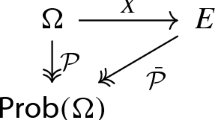Abstract.
Given a controlled stochastic process, the reachability set is the collection of all initial data from which the state process can be driven into a target set at a specified time. Differential properties of these sets are studied by the dynamic programming principle which is proved by the Jankov-von Neumann measurable selection theorem. This principle implies that the reachability sets satisfy a geometric partial differential equation, which is the analogue of the Hamilton-Jacobi-Bellman equation for this problem. By appropriately choosing the controlled process, this connection provides a stochastic representation for mean curvature type geometric flows. Another application is the super-replication problem in financial mathematics. Several applications in this direction are also discussed.
Similar content being viewed by others
Author information
Authors and Affiliations
Additional information
Received October 24, 2000 / final version received July 24, 2001¶Published online November 27, 2001
Rights and permissions
About this article
Cite this article
Soner, H., Touzi, N. Dynamic programming for stochastic target problems and geometric flows. J. Eur. Math. Soc. 4, 201–236 (2002). https://doi.org/10.1007/s100970100039
Issue Date:
DOI: https://doi.org/10.1007/s100970100039




